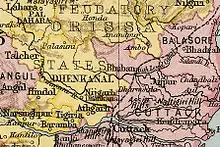Dhenkanal (State)
Dhenkanal State was one of the princely states of India during the period of the British Raj. The state is now referred to as Dhenkanal district, Odisha, with Dhenkanal town as its district headquarters.
| Dhenkanal State ଢେଙ୍କାନାଳ | |||||||
|---|---|---|---|---|---|---|---|
| Princely State of British India | |||||||
| 1529–1948 | |||||||
 Flag
 Coat of arms
| |||||||
 Dhenkanal State in the Imperial Gazetteer of India | |||||||
| Area | |||||||
• 1892 | 3,789 km2 (1,463 sq mi) | ||||||
| Population | |||||||
• 1892 | 273662 | ||||||
| History | |||||||
• Established | 1529 | ||||||
| 1948 | |||||||
| |||||||
_Dhenkanal%252C_Odisha.JPG.webp)
History
Foundation of Dhenkanal State
In 1529 AD Dhenkanal is reported to have been a tribal kingdom under the rule of Dhenka Sabara. A campaign launched by the Southern Division Commander and Bebarta (minister) of the Gajapati Maharaja of Utkal, Sri Sri Pratap Rudra Deb brought it under the umbrage of the larger kingdom. Dhenkanal, situated 150 km north of Puri, was conquered by the Bebarta using a force of cavalry and foot soldiers in a battle between the Gajapati's army and Dhenka Sabara, the ruling chief. The Bebarta was then appointed by Gajapati Maharaja as the Raja of Dhenkanal and the Raja became the hereditary ruler of Dhenkanal. The conquest brought the remote area under the control of the larger Utkal State and strengthened it against further attacks.
A few centuries later it withstood the attack by the Maratha. Raja Bhagirathi Pratap was a very popular and effective ruler, who was decorated with hereditary title of Mahindra Bahadur.
20th century
Raja Sri Sura Pratap Singh Deo Mahindra Bahadur's eldest son, Prince Shankar Pratap, became Raja in the year 1926. He was young and still studying. Subsequently, he went to England to study Bar at Law. After his return to Dhenkanal, he put his mind to administration.
While Raja Sri Shankar Pratap Singh Deo Mahindra Bahadur was in England, his younger brother, Pattayat Nrusingha Pratap Singh Deo was ruling over Dhenkanal. He built his 100-room palace at Jatan Nagar with forced labour.[1] The labourers were tortured badly. Raja's Accountant also extracted money from common men. After all these incidents people expected an improved state of affairs after Raja Sri Shankar Pratap would return from abroad and take over administration from his younger brother.
Revolt
Raja Sri Shankar Pratap was more repressive as a result of which the common people rose in revolt. The revolt was organised and mobilized mainly by Harmohan Patnaik, who was the grandson of Dhenkanal Bebarta Jagannath Patnaik and Dewan Damodar Patnaik. Harmohan Patnaik formed the Dhenkanal Praja Mandal and was elected as its president. Same time Sena Adhyaksh Senapati Nakula Samanta Sinhara and Zamindar Sarbarakar Fakira Charana Garnaik from Hindol princely state formed the Hindol Praja Mandal and Nakula Samanta Sinhara was elected as its president. Both the President of Harmohan Patnaik from Dhenkanal princely state and Nakula Samanta Sinhara from Hindol princely state sprang up in all princely states of India. This was the first Praja Mandal [2] of British India and then Praja Mandals sprang up in all princely states of India as public organizations to resist the practices of the then Rajas and Maharajas.
The British military force was mobilized by Raja Saheb to repress a revolt. A young boy named Baji Rout refused to ferry the British military force by his boat.[3] The British Officer opened fire and killed Baji Rout and five villagers. This incident inflamed the nearby villagers and the revolt spread to the entire Dhenkanal State.
The Praja Mandal movement mobilized mass gatherings and a charter of rights was drawn. During the years of struggle, the Indian National Congress also became associated with the Dhenkanal movement. Arrests and imprisonments were a regular occurrence. Whenever Raja Saheb's forces imprisoned Harmohan Patnaik, the people surrounded the Palace in great numbers. Raja Saheb felt threatened and released Harmohan Patnaik unconditionally.
Independence of India
The independence of India in the year 1947 put a stop to the unrest. Raja Sri Shankar Pratap Singh Deo Mahindra Bahadur accepted Harmohan Patnaik as an adviser. Subsequently, princely states were taken over and Rajas and Maharajas were deposed. Raja Sri Shankar Pratap was elected as Member of newly formed Odisha Legislative Assembly. Ranee Smt. Ratna Prabha Devi was an M.L.A. for two terms. Raja Sri Shankar Pratap's son, Brigadier Kamakhya Prasad Singh Deo, became a Member of Indian Parliament and a Minister in the Government of India's cabinet. He was the President of Orissa Pradesh Congress Committee.
Rulers
The rulers had the title of Maharaja from 1869 onward.[4]
Rajas
- 1682 - 1708 Nrusingh Rai Singh Bhramarbar Rai
- 1708 - 1728 Kunja Behari Rai Singh Bhramarbar Rai
- 1728 - 1741 Braja Behari Bhramarbar
- 1741 - 1743 Damodar Rai Singh Bhramarbar
- 1743 - 1785 Trilochan Singh Mahendra Bahadur
- 1785 - 1796 Dayanidhi Mahendra Bahadur
- 1796 - 1807 Ramchandra Mahendra
- 1807 - 1822 Krishna Chandra Mahendra
- 1822 - 1832 Shyam Chandra Mahendra
- 1832 - 1869 Bhagirath Mahendra (b. 1823 - d. 1877)
- 1832 - 1844 .... -Regent
Maharajas
- 1869 - 1877 Bhagirath Mahendra (s.a.)
- 1877 - 1885 Dinabhandu Mahendra (d. 1885)
- 29 Aug 1885 – 16 Oct 1918 Shura Pratap Singh Dev Mahendra (b. 1885 - d. 1918)
- 29 Aug 1885 - 1906 ... -Regent
- 16 Oct 1918 – 15 Aug 1947 Shankar Pratap Singh Dev Mahendra (b. 1904 - d. 1965)
- 03 Aug 1965 - Brig. Raja Kamakhya Prasad Singh Deo Mahindra Bahadur
References
- "Dhenkanal". Orissagateway.com. Retrieved 14 October 2013.
- Orissa Review
- "Freedom Fighters". Dhenkanal.nic.in. Archived from the original on 13 August 2015. Retrieved 14 October 2013.
- Indian Princely States
External links
 Media related to Dhenkanal State at Wikimedia Commons
Media related to Dhenkanal State at Wikimedia Commons- Indian Princely State Dhenkanal Fiscal Court fee and Revenue Stamps